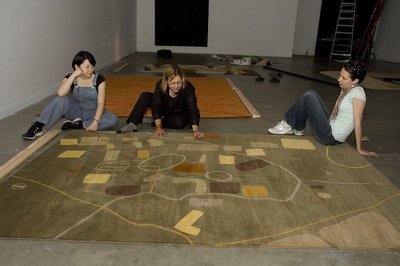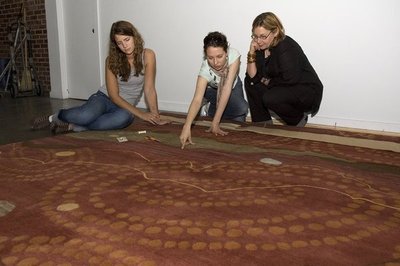July 20, 2006
Magic carpet ride: Students learn commissioning process
Walk Softly, an exhibit of hand-woven carpets that opens July 21 at Consolidated Works, 500 Boren N., is the culmination of work by UW fibers students that began over six months ago.
These students were enrolled in Art 329, “Commissions: The Artist/Client Process,” during winter quarter and worked with a sponsor who had purchased the right to commission a hand-woven carpet. The sponsorship also provided them with the opportunity to take part in the educational process, providing ongoing feedback as their student developed and refined the design. After the students and clients agreed upon a design, the carpets were woven by manufacturers in Nepal and then shipped back to Seattle.
Sponsorship for the 2006 projects, most of which measure 70 square feet, was $4,300 — about half the retail price for custom carpets, but enough to cover all the costs of production and exhibition with a bit left over.
“Each carpet in the exhibit is designed specifically for the client who sponsored it — more specifically, for a site of the client’s choosing,” says Layne Goldsmith, professor of art and chair of the fibers program. Students work on their commissions in Winter Quarter, with carpets woven during the spring. “I have gone to Nepal each March for the past four years, to work with the producers and our production specialist to make sure the carpets are all done as accurately as possible,” she says.
A letter from the director Read a letter from Passang Tshering Dorjee, director of Dorjé Contemporary Carpets LTD. in Kathmandu. He writes about the dedication of “the special group people who made this possible” and the struggles they faced. Read the letter >> |
This year’s clients include President and Mrs. Emmert. One very large carpet was commissioned for the garden room at the President’s residence, Hill-Crest, with a second rug for the President’s office. Both were designed by Satoko Asai Berg, who has taken the class three times and just received her BFA.
“The Emmerts were so pleased with Satoko’s original design for the Hill-Crest carpet that they asked her to work on a design for the President’s office,” Goldsmith says. “This one was completely different, however. It is an abstract design of the campus map and incorporates subtle hues of the Husky colors, purple and gold.”
Goldsmith’s class is not officially a capstone, but most of the students who enroll are seniors. When she first decided to offer the class, Goldsmith received advice and guidance about how to solicit donations. She utilized her professional and personal contacts to establish a list of potential sponsors. Over the life of the course, the number of sponsors has fluctuated between 13 and 21. This year, 18 carpets were commissioned for the 14 sponsors.
Before the first carpets were created, Goldsmith visited Nepal and decided which manufacturers were most suitable. “Child labor and exploitation can be an issue in Nepal,” she said. “I ended up visiting about four dozen manufacturers and their dyeing works. I examined the working conditions of the employees and what kinds of benefits they received, such as education and health care. I’ve also been looking for ways that we can influence companies to institute more fair trade practices.”
Besides learning about the intricacies of the career paths open to students who graduate with a Bachelor of Fine Arts in art, veterans of this course become familiar not just with issues surrounding fair trade, but also the details of contracts, shipping, duties, customs and exhibition. As part of the course, students attend lectures and discussions with artists, collectors, interior designers, attorneys and curators who share their experiences.
Consolidated Works’ hours are 10 a.m.–5 p.m. July 22 and 23, and 3–8 p.m. July 25–27. Suggested donation is $5. This will be the final exhibit at Consolidated Works Gallery, which is closing.




